October 2024
Significant Weather Events:
Things were quiet across the Southern Region, until the end of the month, on the evening of October 30th a strong line of thunderstorms from the Texas Panhandle moved east into Oklahoma after sunset. This storm brought strong winds over 70mph which knocked down trees and power lines. Hail also fell in Central Oklahoma, around 1 inch in most areas, but Orlando, OK saw hail of 1.75 inches in diameter. Overnight, these storms continued to push east into Northeast Oklahoma and Northwest Arkansas where they posed a tornado threat. Nocturnal tornadoes can be extremely dangerous and are far more deadly. That being said, this storm produced an EF-1 tornado near Alton, OK and another EF-1 tornado in Prairie Grove, AR. Thankfully, no injuries or fatalities were reported associated with either storm. As the morning of the 31st came, this line of storms had weakened but was producing much needed rainfall for the Region. Unfortunately, this rain ruined some trick-or-treating plans in Louisiana, Mississippi, and Tennessee.
This was not enough rainfall though, to combat the lack thereof for much of October. Looking at the state of agriculture across the region, Arkansas, Oklahoma, and Texas all have at least 60% short to very short topsoil, with a whopping 78% in Texas. Subsoil moisture is a similar story.
Temperature:
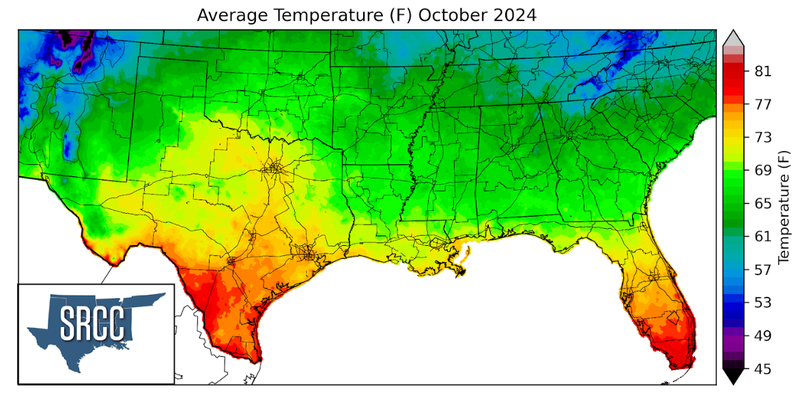
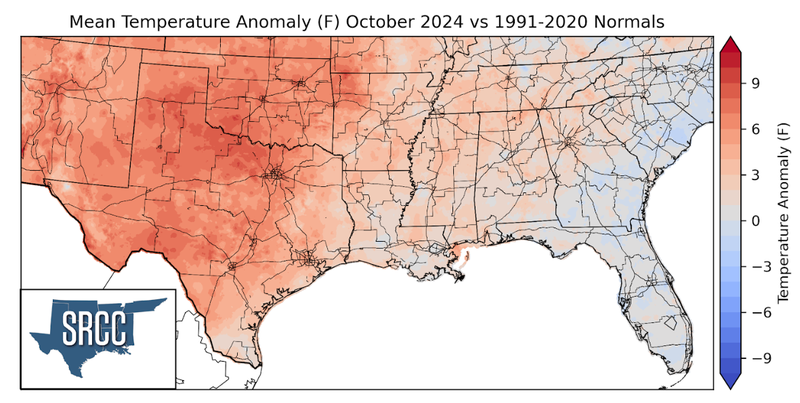
Temperatures were above normal across the Southern Region last month. Moving east across the Region though, this temperature anomaly lessened as temperatures in Tennessee were just slightly above or near normal. Monthly average temperatures were their warmest in North-Central Texas near 7 degrees Fahrenheit above-normal. To start the month, temperatures were moderate. Despite weekly cold fronts temperatures remained quite warm, especially in Texas and Oklahoma where weekly average temperatures were more than 10 degrees above normal. By mid-month the Southern Region finally experienced its first taste of fall-like temperatures as a strong cold front brought crisp and dry air from the north. Behind this cold front morning lows reached as cold as the high forties in Oklahoma. Finally, the month ended with record-setting temperatures from Texas to Arkansas. This all resulted in October’s average temperature for the Southern Region ranging from 62 to 74 degrees in most places. The coldest monthly temperatures for October were found in the Great Smoky Mountains along the Tennessee-North Carolina border where temperatures were as cool as 55 degrees Fahrenheit.
Precipitation:
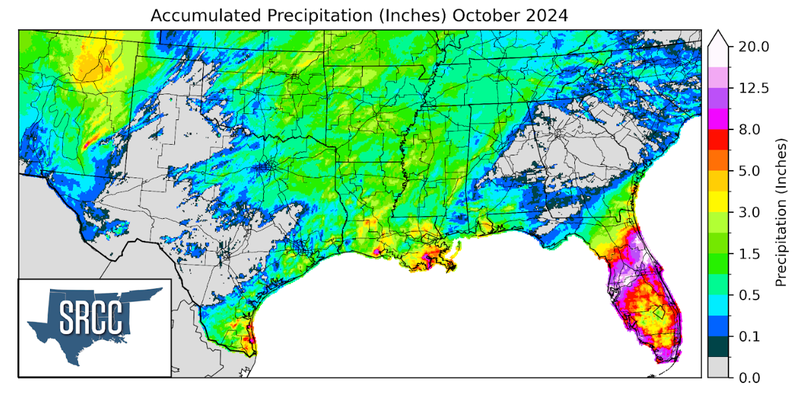
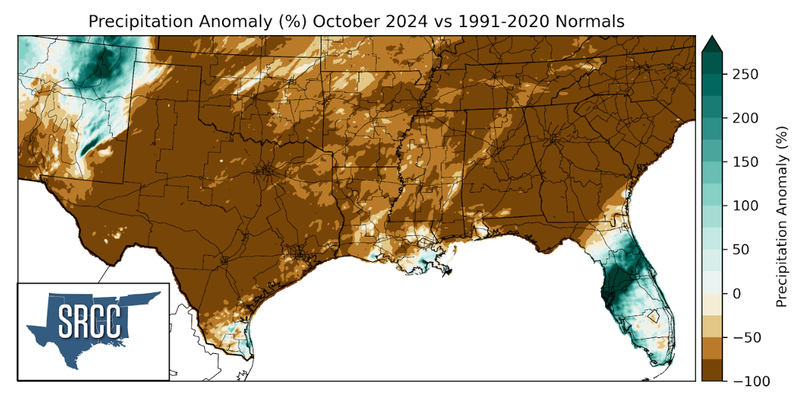
Across the board last month, the Southern Region was abnormally dry. The only areas of the Region that managed to escape these conditions were a small portion of the Texas and Oklahoma Panhandles, the Lower Rio Grande Valley, and Southeast Louisiana. The Northwest portion of the Texas and Oklahoma Panhandles managed to accumulate about 1.5 inches of rain in October, or near normal totals. This was brought on by storms in New Mexico that moved east into the Region. Near-normal rainfall totals in the Lower Rio Grande River Valley and Southeast Louisiana was the product of about 3 inches of tropical rainfall that fell in the first week of October. Despite the Halloween storms that brought widespread rainfall of at least an inch to every state in the Region besides Texas, below normal precipitation totals were still observed as minimal to no rainfall was observed prior to then. As meteorological winter begins, the Southern Region is anticipating more below-normal chances of precipitation in the coming months.
Drought:

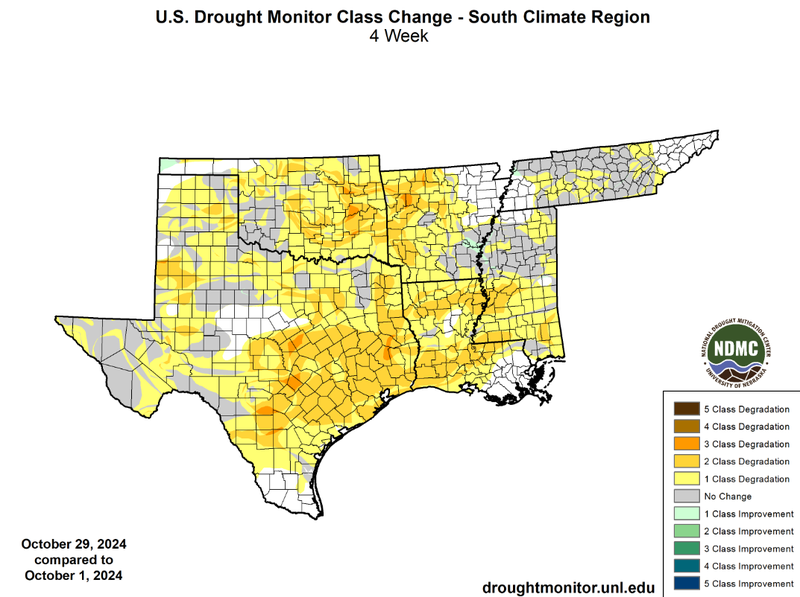
October was warm and dry across the Southern Region, perfect for drought formation and degradation. As mentioned above, near normal amounts of precipitation were limited to the Lower Rio Grande Valley and Southeast Louisiana which were some of the few locations in the Southern Region that did not experience drought in the past month. But much of the Region was not this lucky as widespread drought degradations occurred. Drought in Southeast Texas into Louisiana rapidly declined this month as many areas went over thirty days without any measurable precipitation. Widespread two-class degradations were observed in Southeast Texas and the area is now experiencing severe drought (D2). One-class degradation also occurred across much of Texas leading to a 40% increase of drought (D1 - D4) across the state. More two-class degradations were observed across Central Oklahoma, Western Arkansas, and Southern Mississippi. Additional drought degradation across the Texas-Oklahoma border has resulted in a large region of extreme drought (D3) across much of the Red River, leaving river levels extremely low. Overall, everything discussed above led to drought expansion in the Southern Region this October by 34%. Drought severity also increased across the Region this past month. From the beginning to the end of October, severe to exceptional drought (D2 - D4) increased by 29%.
According to NOAAs U.S. Monthly Drought Outlook for this November, drought is expected to remain yet improve in Oklahoma, Western Arkansas, and North Texas. Drought is expected to persist in West Texas, South Texas, Southern Louisiana, Mississippi, and Tennessee. Finally, drought removal is likely in small areas of Central Oklahoma, North-Central Texas, and Northern Louisiana.
